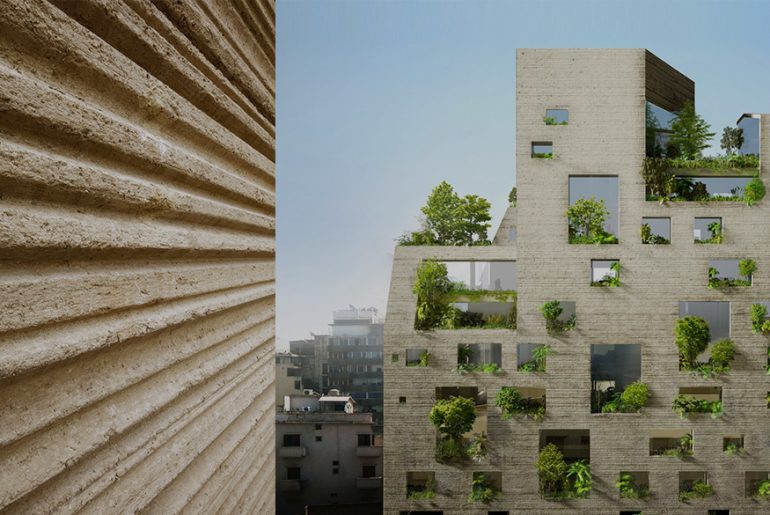Lina Ghotmeh’s “Stone Garden” stands as a symbol of Hope and Life amongst the surviving war-ridden buildings of a tormented Beirut and the concretized contemporary structures of a redeveloping Beirut. This 13 storeyed Residential building resembles an amorphous sculpture with its unique gritty earthy texture and asymmetrical punctures that have gardens with trees reaching up to the sky. The building is a reflection of its architect’s subtle and sustainable approach towards architecture and her desire to preserve the history of a city she grew up in.
Design and Development
The Stone Garden is located downtown, on a site overlooking the Industrial Port of Beirut. This piece of Land was inherited by renowned Photographer Fouad El Khoury, son of a famous Lebanese Architect Pierre El Khoury and was known to house not only his father’s office but also Middle East’s first Concrete Company. The project began in 2011 with the demolition of the existing building and was completed in 2020 as a residential tower with a luxurious multilevel Art Gallery and Cafe on the first floor. ‘I don’t pretend, as an architect, to be able to save the world. When I’m solving a situation, I am creating a new situation. But, on our scale, we are able to provide socially positive spaces accessible to all”, explains Ghotmeh knowing that due to Beirut’s rising Real Estate prices, not many could afford to live in the area where her building stood, but the Art Gallery would definitely encourage Public interaction. Lina Ghotmeh dared to build a unique structure that would reflect Beirut’s culture at a time when the city preferred sparkling towers designed by various Pritzker Laureates.
Building Facade
Post the 1975-90 civil war, the city was slowly re-emerging into an urbanised jungle of modern glass towers and commercial buildings. There was an urgent need to move on and the old buildings bearing scars of war and archaeological ruins that was a reminder of their harsh history were torn down to make way for a brighter future. But the bullet holes on the skins of the older buildings, that would usually depict negative memories was what inspired Ghotmeh to develop a surface texture of her own for the Stone Garden. She believed that a Positive future would emerge from negative things. “I wanted to avoid any industrial process for the facade of Stone Garden, it made sense to leave the imprint of workers’ hands”. Her process began by chiselling clay with a fork and after several attempts and mock-ups, a final finish was approved for the structure. A combination of Metal fibres, bonding agents and earth was applied to the concrete framework and a 3m long customised tool was used by the native Syrian workers to carve out the striations on every surface of the building. The facade was designed to break the monotony with openings of various lengths and sizes that doubled up as frames internally for each unit giving the residents a mesmerizing view of the Sea.
Mass Subtraction concept was used to provide abstract shaped balconies on various levels, large enough to grow gardens that made up for the green that a compact site could not accommodate. She said that it was her way of critiquing the loss of landscape in the city and hoped that it would reflect the ruins of Beirut that were taken over by nature.
Spatial Planning
The architect utilises this longitudinal site to design efficiently by placing the building core in the centre. The lower levels consist of residential units of various configurations on either side of the core. As the building rises, the upper levels are planned to accommodate larger luxurious units including penthouses with studio spaces. Multiple openings on the facade provides ample natural light and cross ventilation making the tower sustainable not just because of its eco-friendly facade but also due to the thoughtful spatial planning. The tower was designed for the Mediterranean climate that it would endure.
Archaeology of the Future
The Stone Garden is a prime example of a building that depicts Lina Ghotmeh’s principle of “Archaeology of the Future”. She describes her understanding of architecture as “Digging into the past while projecting into the future”. Her love for archaeology stems from the city that she grew up in. Living in Beirut during the time of its recovery from war, instilled in Ghotmeh a need to dig into the past and reveal through her buildings, the history of its city.
“Stone Garden is a constant reminder of what Beirut lived, it is an invitation not to repeat history but to cherish life and cohesion”. Mirroring the humanist values of its architect, the Stone Garden is Lina Ghotmeh’s contribution to her city’s future.
Image Sources- www.linaghotmeh.com/en/











